Did you know a healthy lawn only needs one fertilizer a year? This fact shows how crucial proper lawn care is. Your yard is a living space that needs attention. Learning about lawn care can make your outdoor area look great.
Lawn maintenance includes many steps to keep your yard looking good. These steps include mowing, watering, fertilizing, and controlling pests. Doing these things makes your property look better and helps the environment. A well-kept lawn also cools the air and cleans pollutants from it.
Experts have created Best Management Practices (BMPs) for homeowners. These guidelines cover how to water and mow your lawn right. Following these BMPs makes your lawn care better for the planet.
Key Takeaways
- Proper lawn maintenance boosts property value and helps the environment.
- Regular care includes mowing, watering, fertilizing, and pest control.
- Well-maintained lawns cool the air and filter pollutants.
- Best Management Practices help achieve healthy lawns with minimal environmental impact.
- Understanding lawn care basics is key for a lush, green yard.
Understanding Lawn Maintenance Basics
Lawn care is key to a beautiful yard. It means doing regular tasks to keep your grass healthy and looking great. Let’s look at the basics of turf care and why it’s important for your home.
What is Lawn Care?
Lawn care includes all the steps to keep your yard lush and green. This means mowing, watering, fertilizing, and controlling pests. In Illinois, the best lawn height depends on the grass type:
| Grass Type | Ideal Height (inches) |
|---|---|
| Kentucky Bluegrass | 2.5 – 3.5 |
| Fine Fescue | 2.5 – 4 |
| Tall Fescue | 2 – 3 |
| Perennial Ryegrass | 1.5 – 2.5 |
Benefits of a Well-Maintained Lawn
A well-kept lawn has many benefits. It raises your property value, improves air quality, and prevents soil erosion. Plus, it fights diseases and pests, saving you time and money on upkeep.
Key Components of Lawn Maintenance
Good lawn care includes several important steps. Cutting your grass right keeps it healthy. Watering it about 1.5 inches a week, including rain, keeps it hydrated. Fertilizing with the right amount of nitrogen helps it grow strong.
For cool-season grasses in Illinois, use 2 to 4 pounds of nitrogen per 1,000 square feet over the season. Remember to test your soil yearly and aerate regularly to keep your lawn perfect.
“A focus on building rich, healthy soil rather than solely feeding the grass can lead to long-term benefits and reduced maintenance costs.”
By learning these lawn care basics, you’ll be on your way to a beautiful, thriving yard that everyone will admire.
Proper Mowing Techniques
Learning how to mow your lawn right is crucial for a healthy, green yard. Cutting your grass correctly helps it grow strong and thick. Let’s look at the key parts of mowing well.
Ideal Mowing Height for Different Grass Types
The best height to cut your grass depends on the type of grass you have. Here’s a simple guide:
| Grass Type | Ideal Mowing Height (inches) |
|---|---|
| Bahiagrass | 3.5 – 4 |
| Centipedegrass | 1 – 2 |
| St. Augustinegrass (standard) | 3.5 – 4 |
| St. Augustinegrass (semidwarf) | 2 – 2.5 |
| Zoysiagrass | 1.5 – 2 |
Frequency and Timing of Mowing
Mowing your lawn regularly is key to keeping it weed-free. Cutting it every week helps keep growth even. In summer, warm-season grasses like St. Augustinegrass need more cuts. Cool-season grasses may need less as it gets cooler.
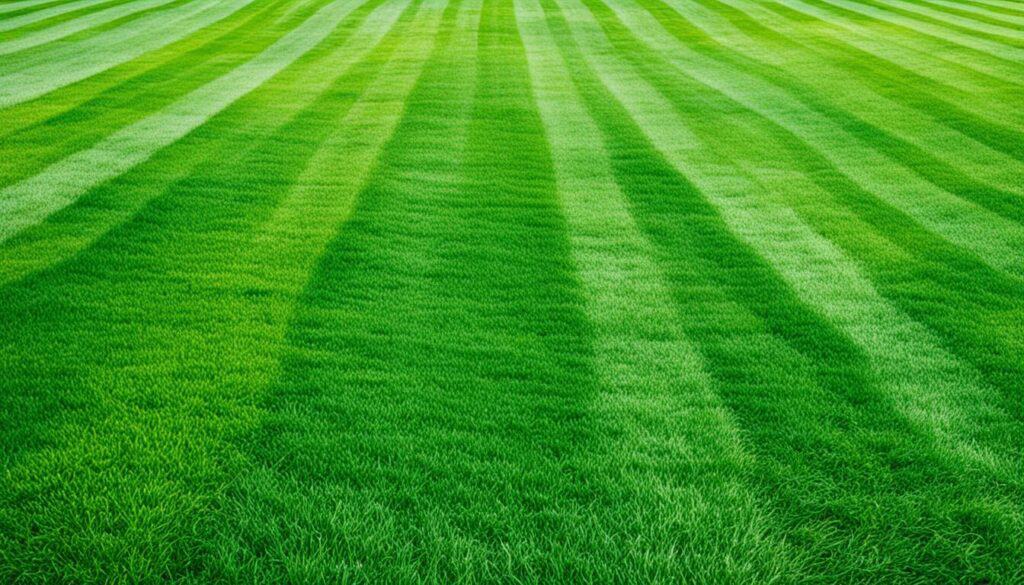
Proper Equipment Maintenance
Keep your mower running smoothly for the best results. Sharpen the blades often to prevent tearing the grass. A blade sharpening kit is just $10 and greatly improves your cuts. Clean the blades every day to stop fungal diseases.
“A good rule of thumb for mowing is to cut only 1/3 of the length of grass blades, maintaining grass between 2 ½ – 3 ½ inches tall.”
Using the right mowing techniques makes your lawn healthier and more resistant to drought. Follow these tips for a lush, beautiful lawn.
Watering Strategies for a Healthy Lawn
Proper lawn irrigation is key for a green yard. Knowing the best ways to water can make your lawn look great and save water.
Best practices for lawn irrigation
Lawns need about 1-1.5 inches of water each week. Water deeply but not too often to help roots grow strong. Try watering for 45 minutes to an hour at a time to keep soil moist.
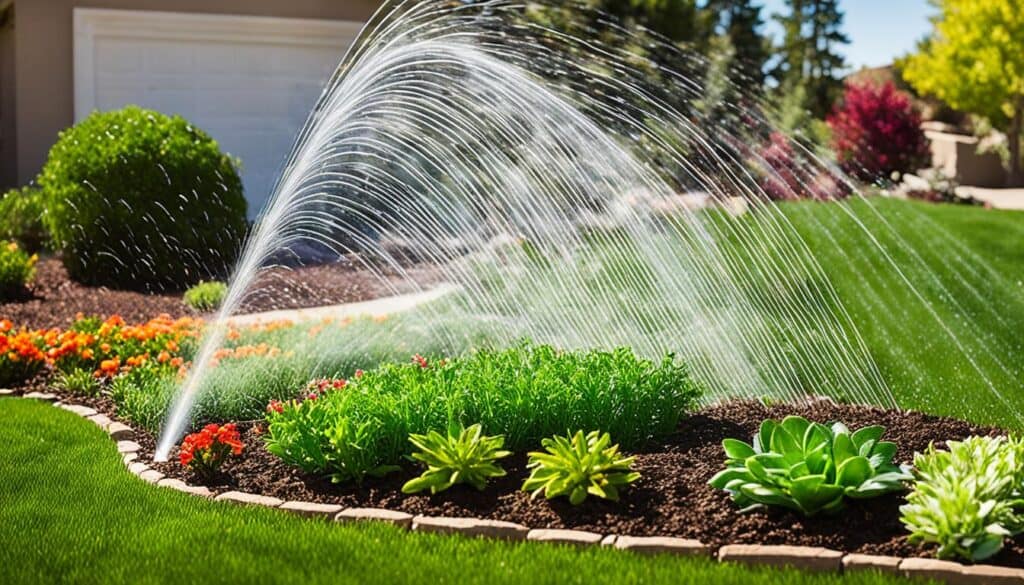
When to water matters a lot. Water in the early morning or late afternoon to cut down on evaporation. Don’t water in the afternoon because a lot of water can evaporate quickly.
Signs of overwatering and underwatering
Keep an eye on your lawn for signs of water stress. If you see folded leaf blades or a blue-gray color, or if you can see footprints, your lawn might be thirsty. On the other hand, too much water can cause diseases, weeds, and pests.
Water conservation techniques
Use smart ways to save water and keep your lawn healthy:
- Use rain sensors to measure precipitation and adjust irrigation accordingly
- Position sprinklers strategically to cover maximum turf area
- Consider drought-tolerant grass varieties
- Water shaded areas less frequently than sunny spots
| Season | Watering Frequency | Water Amount |
|---|---|---|
| Spring | Weekly | 2.5 cm |
| Summer | More frequent | 2.5-3 cm |
| Fall | Weekly until ground freeze | 2.5 cm |
| Winter | Pause watering | N/A |
Follow these tips to keep your lawn looking great while using water wisely.
Fertilization and Soil Management
Proper fertilizing and soil management are essential for a healthy yard. Your grass needs the right nutrients to grow well. A soil test shows what your lawn lacks, helping you pick the best fertilizer mix.
Fertilizers have key elements like nitrogen, phosphorus, and potassium. Nitrogen makes leaves grow, phosphorus helps roots, and potassium boosts health. These elements are crucial for plant growth.
When to fertilize is important. Late summer and early spring are best for most grasses. Fertilize when your grass is growing well. This way, the nutrients get used right. Don’t forget to water after applying to help the fertilizer soak in.
Soil type changes how you care for your lawn. Sandy soils drain fast but lose nutrients quickly. Clay soils hold water and nutrients but can get compacted. Loamy soil is best, offering good drainage and nutrient holding.
| Soil Type | Characteristics | Management Tips |
|---|---|---|
| Sandy | Fast draining, low nutrient retention | Frequent, light fertilization; add organic matter |
| Clay | Slow draining, high nutrient retention | Aerate regularly; add gypsum to improve structure |
| Loamy | Balanced drainage and nutrient retention | Maintain with regular fertilization and aeration |
Soil pH is key in lawn care. Most grasses like a pH between 6.0 and 7.0. If your soil is too acidic, add lime. For alkaline soil, use sulfur. These steps help your grass take in nutrients better.
Pest and Weed Control in Lawn Care
Keeping your lawn healthy is more than just cutting the grass and watering it. You also need to control pests and weeds. Let’s look at some good ways to handle these lawn care issues.
Common lawn pests and diseases
Insects and their larvae can harm your grass and shrubs. Brown Patch disease is a big problem in many places, especially in the U.S. It’s important to stop and treat these problems quickly because they spread fast.
Integrated pest management techniques
An Integrated Pest Management (IPM) approach is a green way to fight pests. This method means watching for pests, figuring out who they are, and using safe methods before using chemicals. Adding helpful insects can also keep your lawn balanced.
Effective weed control strategies
Weeds like Crabgrass, Dandelion, and Plantains can quickly take over your lawn. Keeping your grass the right height and not watering too much can stop weeds. Using native plants and ones that can handle drought can also help. Make sure to wait 24-48 hours after putting down before mowing. This helps your lawn absorb nutrients better and control weeds well.
FAQ
What is lawn maintenance?
Lawn maintenance means taking care of your grass. This includes mowing, watering, fertilizing, and controlling pests. It keeps your grass healthy and looks good.
Why is lawn maintenance important?
A well-kept lawn boosts your property’s value and improves air quality. It also helps prevent soil erosion and looks better. Plus, it needs less upkeep when done right.
What are the key components of lawn maintenance?
Key parts of lawn care are mowing, watering, fertilizing, and pest control. Using Best Management Practices (BMPs) helps your lawn stay healthy. It also reduces harm to the environment.
How often should I mow my lawn?
Mow often when your grass is growing, but don’t cut off more than 1/3 of the blade. How often depends on the type of grass and how fast it grows.
What is the ideal mowing height for different grass types?
The best mowing height changes with the grass type. For Bahiagrass, it’s 3.5-4″. Centipedegrass should be cut at 1-2″. St. Augustinegrass is best at 3.5-4″ or 2-2.5″ for semidwarf types. Zoysiagrass should be mowed at 1.5-2″.
How can I water my lawn efficiently?
Water your lawn when it looks thirsty, like when the blades fold or turn blue-gray. Use 1/2 to 3/4 inch of water each time, based on the soil. Water less often but for longer to help the roots grow deep.
Why is proper fertilization important for lawns?
Fertilizing your lawn right is key for its health. Use slow-release nitrogen fertilizers to prevent damage. Test your soil to see what nutrients it needs. Fertilize during the growing season, skipping the dormant period.
How can I control pests and weeds in my lawn?
Use Integrated Pest Management (IPM) for safe pest control. Watch for pests and diseases, and use non-chemical methods first. Consider adding beneficial insects or organisms. Keep your grass at the right height and don’t overwater to stop weeds.

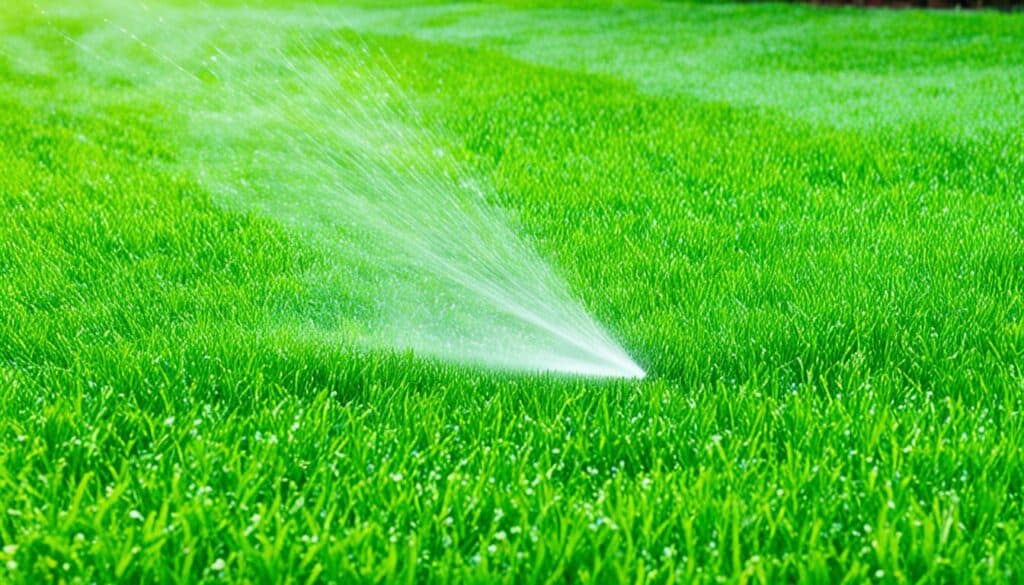
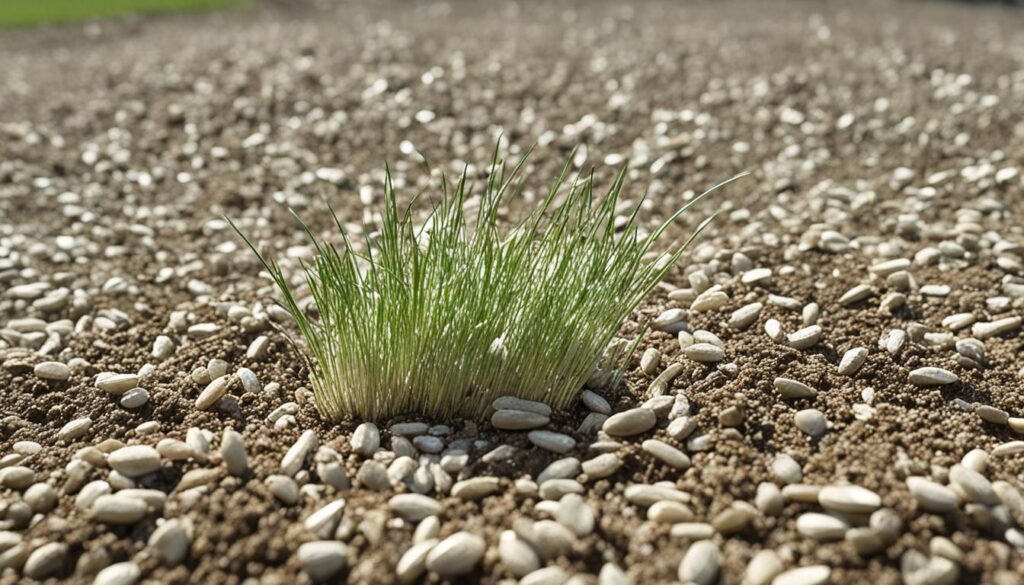
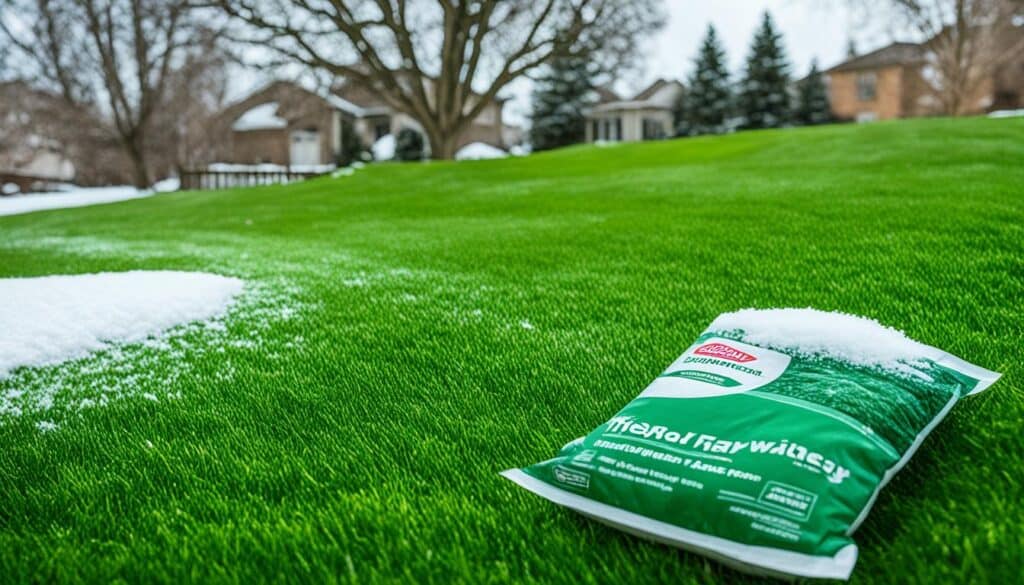
Thanks for sharing. I read many of your blog posts, cool, your blog is very good.